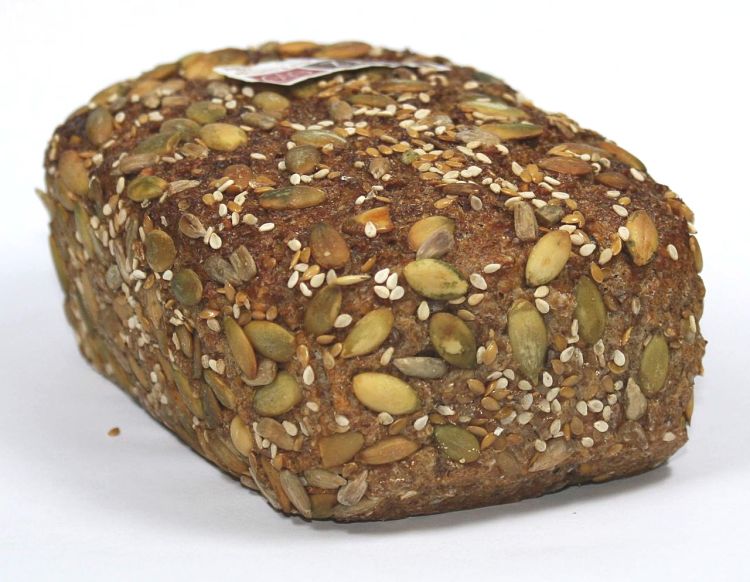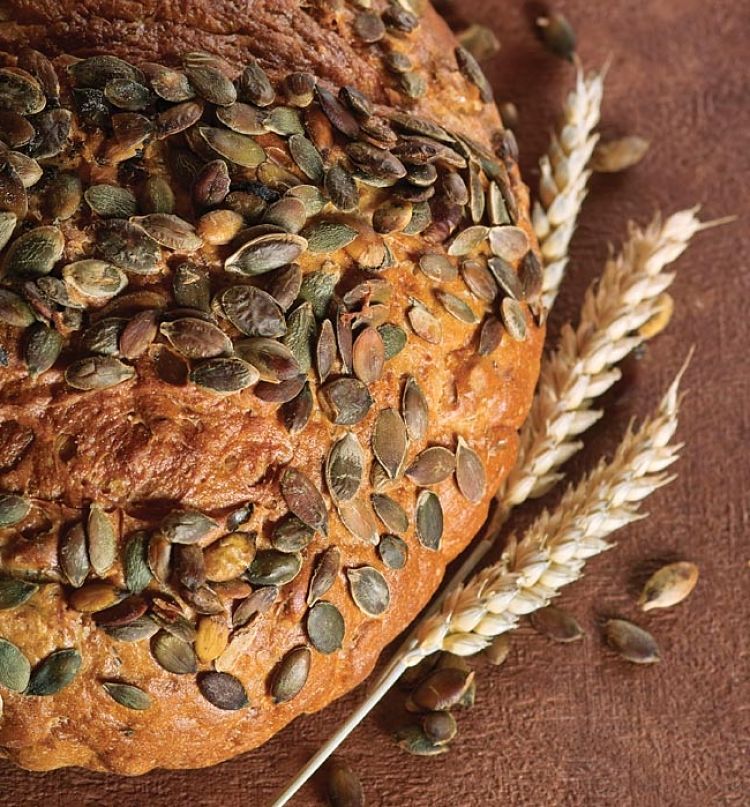Pumpkin Seed Health Benefits, Nutritional Information, Uses and Recipes
Despite their humble reputation, pumpkins seeds are very healthy and nutritious and are very versatile in their uses both as snack foods and as an addition to cakes, cookies main meals and toppings for cakes and slices.
They have a sweet and nutty taste and can be used as an alternative to nuts, whether roasted or raw. Pumpkins belong to the Cucurbitaceae or gourd family like cucumber, cantaloupe and the many species of squash.
The seeds are generally available year round as a by-product of pumpkin processing, the seeds are at their best in late fall pumpkins are harvested. Pumpkin seeds come in a variety of shapes and forms, They are also known as pepitas.
They are generally flat, dark green seeds, that are often enclosed in a white or yellow husk, that is quite edible (full of fiber).
Some species of pumpkin and squash have seeds with no husks and to can buy them husked - both raw and roasted. This article aims to showcase the nutritional highlights of pumpkin seeds and outline some of their many uses.

Comparison between Pumpkin Seeds and Common Nuts
Pumpkin seeds are a rich food with relatively high amounts of fat and calories similar to needs and many seeds. So they should be eaten sparingly.
A single cup of pumpkin seeds contains about 300 calories, which quite high, but few people would eat that many. As shown in the table pumpkin seeds have the lowest calorie counts of all the other nuts and seeds on the list.
They also have the lowest fat, except for pistachios. Significantly pumpkin seeds have the lowest fat to protein ratio of any food on the list, which means that although the protein levels are only in the middle of the range, the protein comes with much lower level of fat.
This makes pumpkin seeds one of the best high energy, higher protein and low fat foods in the seed and nuts group.
|
Food ( 1 oz)
|
Calories
|
Tot. Carb
|
Fiber
|
Total Fat
|
Sat. Fat
|
Mono Fat
|
Protein
|
Fat to Protein Ratio
|
|---|---|---|---|---|---|---|---|---|
|
Pumpkin Seeds
|
151
|
5
|
1.1
|
13
|
2.4
|
4
|
6.9
|
1.28
|
|
Sesame Seeds
|
160
|
6.6
|
3.3
|
17.5
|
1.9
|
5.3
|
7
|
2.77
|
|
Sunflower Seeds
|
164
|
5.6
|
2.4
|
16
|
1.2
|
5.2
|
7.2
|
2.48
|
|
Walnuts
|
183
|
3.8
|
1.9
|
26
|
1.7
|
2.5
|
3
|
4.22
|
|
Pine Nuts
|
188
|
3.7
|
1
|
19
|
1.4
|
5.3
|
3.9
|
4.2
|
|
Pistachios
|
156
|
7.8
|
2.9
|
12
|
1.5
|
6.5
|
7
|
2.2
|
|
Peanuts
|
159
|
4.5
|
2.4
|
17
|
1.9
|
6.8
|
9
|
1.89
|
|
Cashews
|
155
|
9.2
|
0.9
|
16
|
2.2
|
6.7
|
5.3
|
2.44
|
|
Almonds
|
161
|
6.1
|
3.4
|
17
|
1
|
8.6
|
7.7
|
2.35
|
|
Brazil Nuts
|
184
|
3.4
|
2.1
|
23
|
4.2
|
6.9
|
5.5
|
4.63
|
|
Pecans
|
193
|
3.9
|
2.7
|
23
|
1.7
|
11.4
|
3
|
7.8
|
|
Hazelnuts
|
176
|
4.7
|
2.7
|
17
|
1.3
|
12.8
|
5.3
|
4.12
|
|
Madadamia Nuts
|
201
|
4
|
2.4
|
25
|
3.4
|
16.5
|
3
|
9.27
|
Pumpkin Seeds are an excellent source of the minerals manganese, magnesium and phosphorus. They are also a good source of iron, copper and zinc.
Eating a quarter-cup of pumpkin seeds as a snack will provide about:
- 45% of your daily allowance for magnesium,
- 30% of your daily allowance for iron
- 50% of your daily allowance for manganese
- 25% of your daily allowance for copper
- 17% of your daily allowance for protein
- 17% of your daily allowance for zinc
Pumpkin seeds have a very low glycemic index. Roasted pumpkin seeds have a glycemic load of about 10 per ounce
Pumpkin seeds have a good fiber content, with one ounce containing about 1 gram of dietary fiber.
Pumpkin seeds contain a small amount of vitamin C and are rich in B group vitamins. They also have moderate levels of vitamin K.and vitamin E.
Raw pumpkin seeds contain high levels of the antioxidant lutein, which is important for healthy eyes.
Pumpkin seeds also have significant levels of phytosterols, with about 260 mg per 100 grams. These phytosterols are known to help lower the absorption of LDL cholesterol.
Pumpkin Seeds Nutrition
|
Nutrient
|
1/4 cup
|
|---|---|
|
total weight
|
32.25 g
|
|
calories
|
180.28
|
|
calories from fat
|
142.37
|
|
protein
|
9.75 g
|
|
carbohydrates
|
3.45 g
|
|
dietary fiber
|
1.94 g
|
|
sugar - total
|
0.45 g
|
|
other carbs
|
1.07 g
|
|
fat - total
|
15.82 g
|
|
saturated fat
|
2.79 g
|
|
mono fat
|
5.24 g
|
|
poly fat
|
6.76 g
|
|
trans fatty acids
|
0.02 g
|
|
cholesterol
|
0.00 mg
|
|
vitamin A IU
|
5.16 IU
|
|
vitamin A RAE
|
0.26 RAE
|
|
A - carotenoid
|
0.52 RE
|
|
A - beta carotene
|
2.90 mcg
|
|
thiamin - B1
|
0.09 mg
|
|
riboflavin - B2
|
0.05 mg
|
|
niacin - B3
|
1.61 mg
|
|
niacin equiv
|
4.41 mg
|
|
vitamin B6
|
0.05 mg
|
|
vitamin B12
|
0.00 mcg
|
|
vitamin C
|
0.61 mg
|
|
vitamin E alpha equiv
|
0.70 mg
|
|
folate
|
18.70 mcg
|
|
vitamin K
|
2.35 mcg
|
|
pantothenic acid
|
0.24 mg
|
|
calcium
|
14.84 mg
|
|
copper
|
0.43 mg
|
|
iron
|
2.84 mg
|
|
magnesium
|
190.92 mg
|
|
phosphorus
|
397.64 mg
|
|
potassium
|
260.90 mg
|
|
selenium
|
3.03 mcg
|
|
sodium
|
2.26 mg
|
|
zinc
|
2.52 mg
|
How to Select and Store Pumpkin Seeds
Most pumpkin seeds are obtained pre-packaged in various containers or you can buy them in bulk at health food stores. When checking them prior to purchase make sure that there is no signs of dirt or moisture, mold or insect damage. Also check that the seeds are plump and firm and not wrinkled or shrivelled. Also smell the pumpkin seeds, to ensure that they are not rancid or have a musty which may be a sign of mold or deterioration..
Once the packages are opened, stored the pumpkin seeds in airtight containers in the refrigerator.
Tips for Homemade Pumpkin Seeds
While you can buy pumpkin seeds easily it is still fun and worthwhile to prepare your own from your pumpkins. Simply remove the seeds from the inner chamber of the pumpkin , wash them and thoroughly dry them with a paper towel. Then spread them out as a single layer on a piece of brown paper or baking paper to dry overnight.
To roast them. transfer the seeds as a single layer to a baking sheet and roast them at 165 degrees F (about 75 degrees C) in your oven for about 15-20 minutes.
Uses for Pumpkin Seeds
- Sprinkle pumpkin seeds over sauteed vegetables.
- Add seeds to homemade bread, cakes and pancakes
- Sprinkle pumpkin seeds into mixed fresh green salads.
- Blend pumpkin seeds into homemade pesto or homemade salad dressing. Blend fresh garlic, pumpkin seeds, parsley and cilantro leaves with a little olive oil and lemon juice.
- Add chopped pumpkin seeds to hot or cold muesli or cereal.
- Use pumpkin seeds as a topping for oatmeal and raisin cookies or for a granola recipe.
- Add pumpkin seeds to homemade vegetable, turkey or beef burgers.
- Add to nuts and raisins for snack-packs
Pumpkin and Pumpkin Seed (Pepitas) Recipes
=> Baked Pumpkin Puree Recipes, Many Uses for Pureed Pumpkin
=> Spicy, Savory, Easy Pumpkin Pie with Molasses, Almond Flour, Yogurt
=> Best Pumpkin Seed Recipes - How and Why You Should Use Pepitas More Often
=> Stuffed Squash Blossom Recipes - Pumpkin Flowers Filled and Deep Fried







